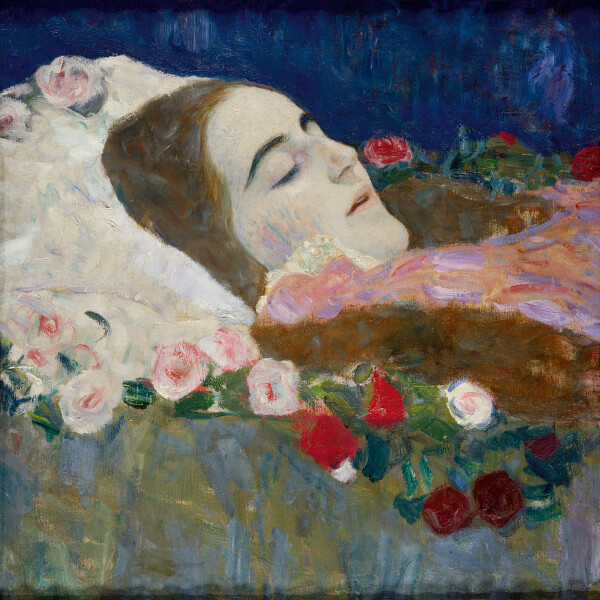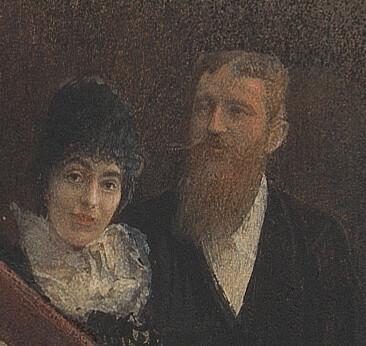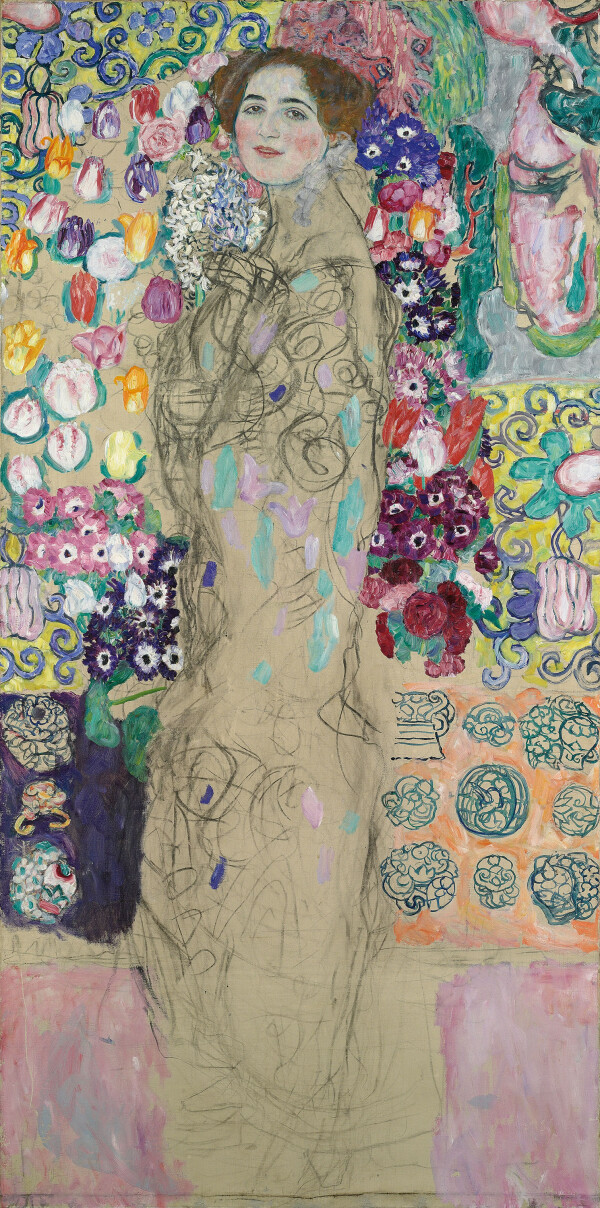The Munks

Gustav Klimt: Portrait of Ria Munk on Her Deathbed, 1912, private collection
© Courtesy Richard Nagy Ltd., London
Alexander Munk and his wife Aranka were influential industrialists from Vienna and related to the Austrian-Jewish Lederer family, who owned one of the largest Klimt collections. In the 1910s, the Munks commissioned the painter Gustav Klimt to create several portraits of their deceased daughter Maria.
Aranka Munk was born in Hungary as the daughter of the landowner Simon Pulitzer and his wife Charlotte in 1862. Her three sisters Irma, Eugenie – called “Jenny” – and Serena married into the wealthy Politzer, Steiner and Lederer families. In 1882, Aranka herself married the industrialist Kommerzialrat Alexander Munk, born in Galicia in 1852. They had four daughters, only two of whom survived into adulthood. The Munks divorced in 1913. Alexander Munk died in 1924.

Alexander and Aranka Munk, detail from Gustav Klimt: Auditorium in the old Burgtheater, 1888, Wien Museum
© Wien Museum

Gustav Klimt: Portrait of Ria Munk III, 1917, The Lewis Collection
© Christie’s Images Limited
Gustav Klimt’s Vignette Portraits
A rare portrait of both Alexander and Aranka Munk can be found in Gustav Klimt’s Auditorium of the Old Burgtheater (1888/89, Wien Museum, Vienna). Painting from photographs, Klimt portrayed numerous public figures in this work. According to the surviving notes of the photographer Josef Löwy, who created a heliogravure and an overview of persons for this work (around 1889, Wien Museum, Vienna), Klimt also created vignette portraits of the Munks and other members of the Pulitzer family for his watercolor and placed them in two boxes in the third balcony.
Posthumous Portraits of Their Daughter
Maria, called “Ria,” the daughter of Aranka and Alexander Munk, committed suicide in 1911, when she was just 24 years old. Her parents subsequently commissioned Gustav Klimt to create portraits of their deceased daughter. It is presumed that Klimt’s patrons Serena and August Lederer recommended the painter to the Munks. The first work, Portrait of Ria Munk on Her Deathbed (privately owned), was created in 1912. The process is thought to have been difficult and cumbersome for Gustav Klimt. He wrote in a message to Emilie Flöge in 1912:
“Have managed to put off delivery of her daughter’s portrait with Mrs. M. until the autumn, I am glad about it.”
One year later he created another painting for the Munks – presumably The Dancer (Ria Munk) (around 1916/17, privately owned). Frustrated, Klimt wrote to Emilie Flöge, who was staying in Paris at the time:
“The Munk portrait is becoming a sore, painful spot – I can’t pull it off! No likeness!”
A third portrait of their deceased daughter was created in 1917. The painting Portrait of a Lady (Ria Munk) (1917 (unfinished), The Lewis Collection) remained unfinished, however, and passed into the ownership of Aranka Munk after Gustav Klimt’s death.
Deportation and Seizure of Their Possessions
Aranka Munk and her daughter Lola were deported to Poland in 1941, where Aranka died the same year. One year later the family’s entire movable and immovable property in Vienna and Bad Aussee was seized. After World War II, mother and daughter were officially listed as missing. Jenny Steiner – their sister and aunt, respectively – had them declared dead by a court in 1949.
Most Recent Restitution
The painting Portrait of a Lady (Ria Munk) was restituted by the LENTOS art museum to the family’s rightful heirs in 2009, after the city of Linz had issued a recommendation in the matter. One year later, the work was sold through Christie's. The painting had originally passed into the ownership of the museum via the art trader Wolfgang Gurlitt in the 1950s.
Literature and sources
- Tobias G. Natter (Hg.): Gustav Klimt. Sämtliche Gemälde, Vienna 2012.
- Alfred Weidinger (Hg.): Gustav Klimt, Munich - Berlin - London - New York 2007.
- Ursula Storch (Hg.): Klimt. Die Sammlung des Wien Museums, Ausst.-Kat., Vienna Museum (Vienna), 16.05.2012–07.10.2012, Vienna 2012.
- Tobias G. Natter, Franz Smola, Peter Weinhäupl (Hg.): Klimt persönlich. Bilder – Briefe – Einblicke, Ausst.-Kat., Leopold Museum (Vienna), 24.02.2012–27.08.2012, Vienna 2012.
- Georg Gaugusch: Wer einmal war. Das jüdische Großbürgertum Wiens 1800–1938, Band 2, Vienna 2016.
- Sophie Lillie: Was einmal war. Handbuch der enteigneten Kunstsammlungen Wiens, Vienna 2003, S. 6.
- Die Presse. www.diepresse.com/569581/christies-versteigert-restituiertes-klimt-portrat (04/28/2020).
- Ansichtskarte von Gustav Klimt in Wien an Emilie Flöge in Paris, 2. Karte (28.02.1913). RL 2874, .
- N. N.: Lebensmüde, in: Neues Wiener Tagblatt, 29.12.1911, S. 8.
- Ansichtskarte von Gustav Klimt in Wien an Emilie Flöge in Bad Gastein, 2. Karte (Morgen) (26.06.1912). RL 2861, .

